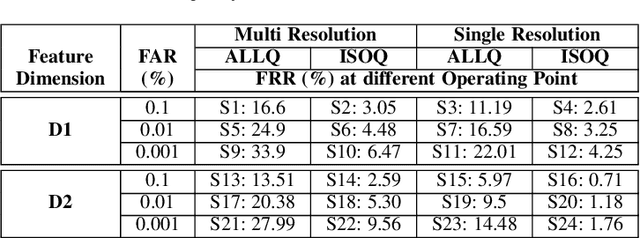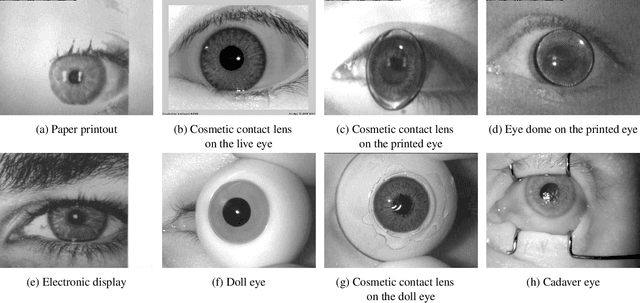Priyanka Das
Uniqueness of Iris Pattern Based on AR Model
Jun 21, 2023Abstract:The assessment of iris uniqueness plays a crucial role in analyzing the capabilities and limitations of iris recognition systems. Among the various methodologies proposed, Daugman's approach to iris uniqueness stands out as one of the most widely accepted. According to Daugman, uniqueness refers to the iris recognition system's ability to enroll an increasing number of classes while maintaining a near-zero probability of collision between new and enrolled classes. Daugman's approach involves creating distinct IrisCode templates for each iris class within the system and evaluating the sustainable population under a fixed Hamming distance between codewords. In our previous work [23], we utilized Rate-Distortion Theory (as it pertains to the limits of error-correction codes) to establish boundaries for the maximum possible population of iris classes supported by Daugman's IrisCode, given the constraint of a fixed Hamming distance between codewords. Building upon that research, we propose a novel methodology to evaluate the scalability of an iris recognition system, while also measuring iris quality. We achieve this by employing a sphere-packing bound for Gaussian codewords and adopting a approach similar to Daugman's, which utilizes relative entropy as a distance measure between iris classes. To demonstrate the efficacy of our methodology, we illustrate its application on two small datasets of iris images. We determine the sustainable maximum population for each dataset based on the quality of the images. By providing these illustrations, we aim to assist researchers in comprehending the limitations inherent in their recognition systems, depending on the quality of their iris databases.
Empirical Assessment of End-to-End Iris Recognition System Capacity
Mar 20, 2023



Abstract:Iris is an established modality in biometric recognition applications including consumer electronics, e-commerce, border security, forensics, and de-duplication of identity at a national scale. In light of the expanding usage of biometric recognition, identity clash (when templates from two different people match) is an imperative factor of consideration for a system's deployment. This study explores system capacity estimation by empirically estimating the constrained capacity of an end-to-end iris recognition system (NIR systems with Daugman-based feature extraction) operating at an acceptable error rate i.e. the number of subjects a system can resolve before encountering an error. We study the impact of six system parameters on an iris recognition system's constrained capacity -- number of enrolled identities, image quality, template dimension, random feature elimination, filter resolution, and system operating point. In our assessment, we analyzed 13.2 million comparisons from 5158 unique identities for each of 24 different system configurations. This work provides a framework to better understand iris recognition system capacity as a function of biometric system configurations beyond the operating point, for large-scale applications.
Adaptive and Scalable Compression of Multispectral Images using VVC
Jan 10, 2023



Abstract:The VVC codec is applied to the task of multispectral image (MSI) compression using adaptive and scalable coding structures. In a 'plain' VVC approach, concepts from picture-to-picture temporal prediction are employed for decorrelation along the MSI's spectral dimension. The popular principle component analysis (PCA) for spectral decorrelation is further evaluated in combination with VVC intra-coding for spatial decorrelation. This approach is referred to as PCA-VVC. A novel adaptive MSI compression algorithm, named HPCLS, is introduced, that uses PCA and inter-prediction for spectral and VVC intra-coding for spatial decorrelation. Further, a novel adaptive scalable approach is proposed, that provides a separately decodable spectrally scaled preview of the MSI in the compressed file. Information contained in the preview is exploited in order to reduce the overall file size. All schemes are evaluated on images from the ARAD HS data set containing outdoor scenes with a high variety in brightness and color. We found that 'Plain' VVC is outperformed by both PCA-VVC and HPCLS. HPCLS shows advantageous rate-distortion (RD) behavior compared to PCA-VVC for reconstruction quality above 51dB PSNR. The performance of the scalable approach is compared to the combination of an independent RGB preview and one of HPCLS or PCA-VVC. The scalable approach shows significant benefit especially at higher preview qualities.
Iris Recognition Performance in Children: A Longitudinal Study
Jan 16, 2021



Abstract:There is uncertainty around the effect of aging of children on biometric characteristics impacting applications relying on biometric recognition, particularly as the time between enrollment and query increases. Though there have been studies of such effects for iris recognition in adults, there have been few studies evaluating impact in children. This paper presents longitudinal analysis from 209 subjects aged 4 to 11 years at enrollment and six additional sessions over a period of 3 years. The influence of time, dilation and enrollment age on iris recognition have been analyzed and their statistical importance has been evaluated. A minor aging effect is noted which is statistically significant, but practically insignificant and is comparatively less important than other variability factors. Practical biometric applications of iris recognition in children are feasible for a time frame of at least 3 years between samples, for ages 4 to 11 years, even in presence of aging, though we note practical difficulties in enrolling young children with cameras not designed for the purpose. To the best of our knowledge, the database used in this study is the only dataset of longitudinal iris images from children for this age group and time period that is available for research.
Iris Liveness Detection Competition (LivDet-Iris) -- The 2020 Edition
Sep 01, 2020



Abstract:Launched in 2013, LivDet-Iris is an international competition series open to academia and industry with the aim to assess and report advances in iris Presentation Attack Detection (PAD). This paper presents results from the fourth competition of the series: LivDet-Iris 2020. This year's competition introduced several novel elements: (a) incorporated new types of attacks (samples displayed on a screen, cadaver eyes and prosthetic eyes), (b) initiated LivDet-Iris as an on-going effort, with a testing protocol available now to everyone via the Biometrics Evaluation and Testing (BEAT)(https://www.idiap.ch/software/beat/) open-source platform to facilitate reproducibility and benchmarking of new algorithms continuously, and (c) performance comparison of the submitted entries with three baseline methods (offered by the University of Notre Dame and Michigan State University), and three open-source iris PAD methods available in the public domain. The best performing entry to the competition reported a weighted average APCER of 59.10\% and a BPCER of 0.46\% over all five attack types. This paper serves as the latest evaluation of iris PAD on a large spectrum of presentation attack instruments.
 Add to Chrome
Add to Chrome Add to Firefox
Add to Firefox Add to Edge
Add to Edge